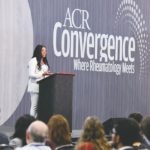Making the Encounter Personal

Dr. Caricchio
The face-to-face encounter has a built-in ethos, with an element of non-verbal and off-the-cuff communication, Dr. Sluss said. “When the encounter is virtual, it’s much more planned, maybe more stilted. Okay, how do we make it feel more personal in the virtual environment?” Expect meetings with fellows to take more time and more energy to read each other when meeting via the camera. Ask open-ended questions, and give them time to reply.
Do they trust us? Do we trust them, and how do we show that? Dr. Sluss posed. Rather than checking up on fellows, thereby suggesting a lack of trust, he recommended checking in with them: “‘Tell me how it’s going. What do you need from me?’ More autonomy for workers should mean more communication with them, not less.” And all of that takes patience, which Sarah Schnitker, Baylor University, Waco, Texas, defines as “the propensity to act calmly in the face of frustration or adversity.”1
Dr. Sluss encouraged division directors to cultivate patience, learn to act calm and go slow when that’s needed, rather than always trying to go faster. The goal is not just operational speed—moving quickly—but strategic speed, reducing the time it takes to deliver value, he said. Leaders should swap their stopwatch for a compass, and prioritize when it’s most important to slow down.
How to handle virtual meetings poses dilemmas because many people say they’re having too many. Yet meetings are essential for building culture. “You can’t overcommunicate in a crisis, and many leaders handled that well. But then they never stopped, continuing to overcommunicate as the pandemic faded,” Dr. Stoverink said.
What’s happening now, the speakers emphasized, is the emergence of hybrid work models in which some employees spend some or all of their work life at home as others return to the office—and to the rheumatology clinic. This represents another massive disruption in work life. Seventy-three percent of employees say they want current flexible work options to stay permanent.
Adaptations to these hybrid work models will need to be nuanced, especially for the team’s culture. Remote is here to stay, while at the same time employees are craving the social connections of the office, Dr. Stoverink said. “But not everyone is ready for business as usual.”
The transition to the pandemic and then to the hybrid model is also an opportunity to stop and revisit, strengthen and even change established office culture, he added. Leaders should decide what kind of culture they want to preserve and what to leave behind. But he also recommended integrating the team into this redesign process.


